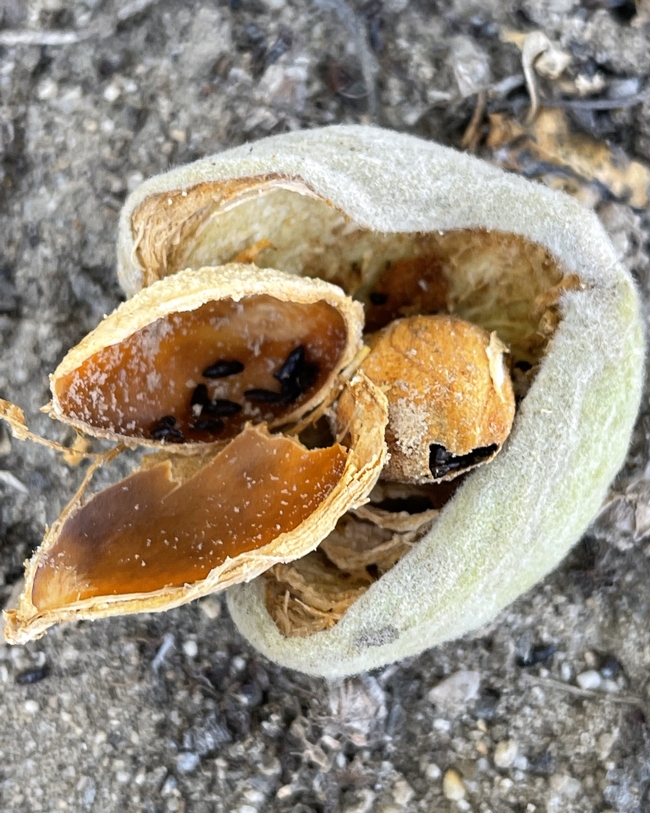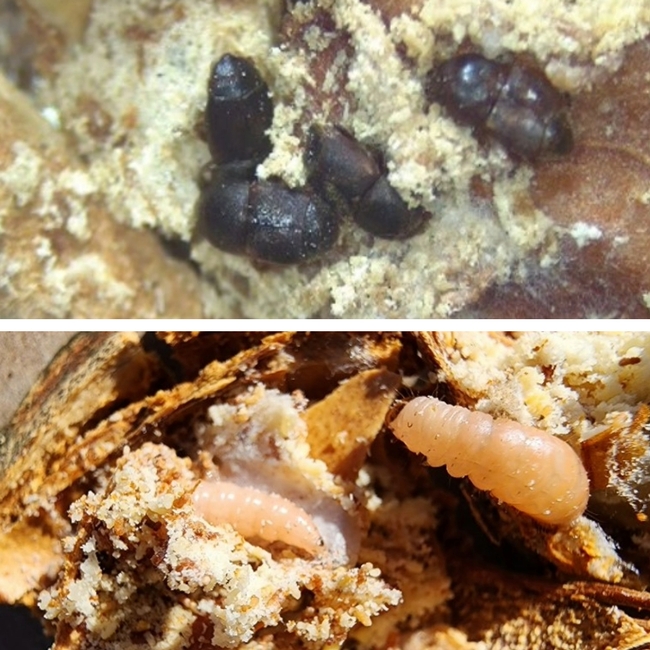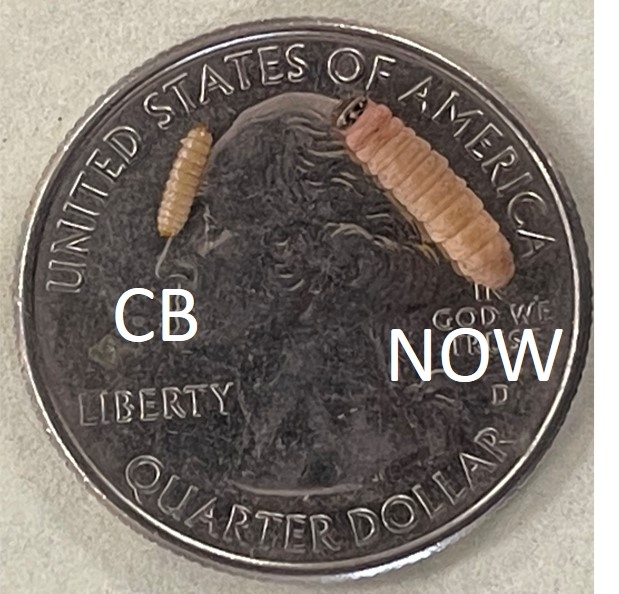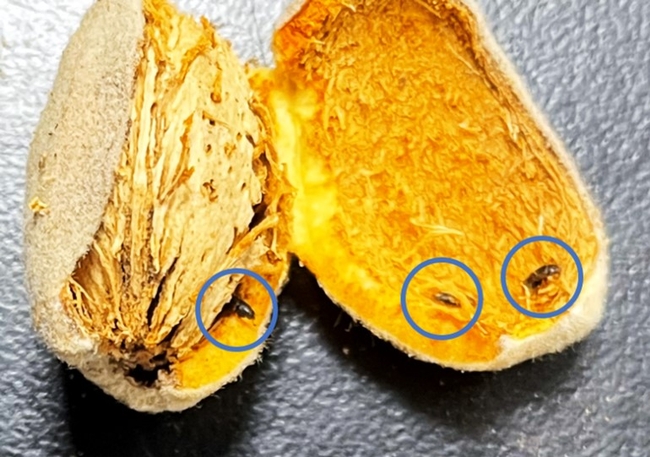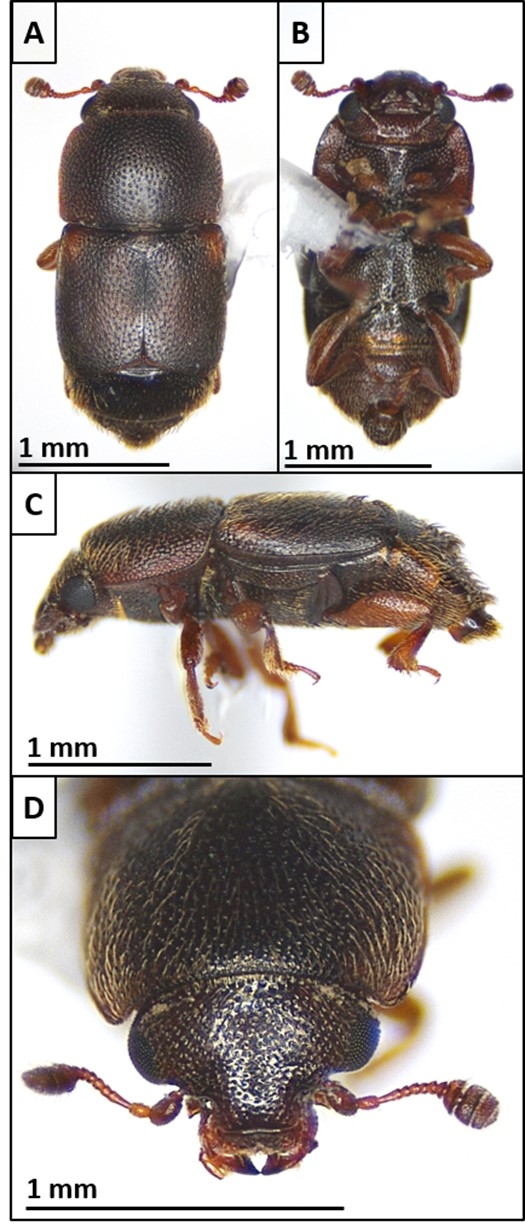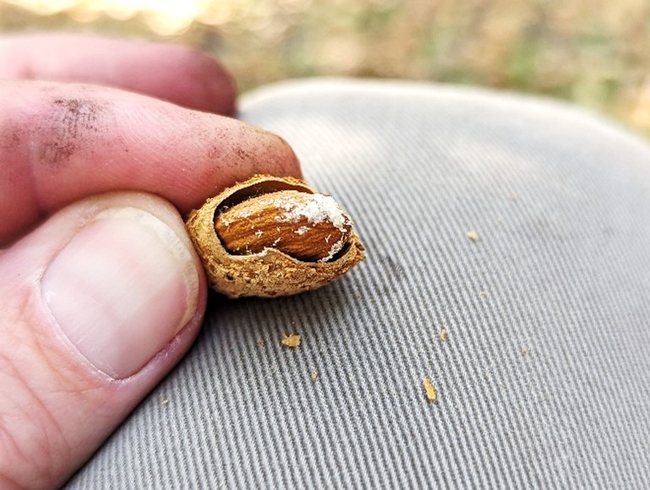Posts Tagged: beetle
Visual ID guide from UC aids in managing new almond pest
Nut orchard hygiene key to control carpophilus beetle, say UCCE, UC Integrated Pest Management experts
Since the first reports of a new almond pest – the carpophilus beetle (Carpophilus truncatus) – came in during fall 2023, it has become clear that the beetle is widely dispersed across the San Joaquin Valley.
“My lab has identified infestations from every county in the San Joaquin Valley; we have found infestations in both almonds and pistachios, and we will likely find infestations in walnuts this fall,” said Houston Wilson, a University of California Cooperative Extension entomology specialist at UC Riverside. The California Department of Food and Agriculture has confirmed the beetle's presence in Stanislaus, Merced, Madera and Kings counties.
Historically a major threat to almond production in Australia, the beetle – as larvae and adults – feeds directly on the nut kernel. In California, some almond growers have lost 10 to 15% of their yield – a “significant economic loss,” according to Jhalendra Rijal, University of California integrated pest management (IPM) advisor for the region. Given the prominence of almonds as a commodity, even a 1% overall reduction statewide represents an approximately $70 million loss.
“This year there has been a lot more reports from PCAs [pest control advisers]; they're sending me the pictures of the damage and beetles,” said Rijal, noting that the increase is likely due to greater awareness of the pest.
To help almond growers identify the carpophilus beetle and develop management plans, Rijal, Wilson and their IPM colleagues have put together a visual ID guide for the beetle and the damage it causes, as well as telltale signs of navel orangeworm (Amyelois transitella) and ant damage. In particular, the experts would like PCAs and growers to differentiate between the carpophilus beetle and navel orangeworm, another key pest in almonds.
“Even though their way of causing damage looks more or less similar, we're dealing with two different types of insects,” Rijal explained. “One is a Lepidoptera moth [navel orangeworm], and the other one is a beetle – many of the management practices and biological controls would be different for these two different things.”
To control carpophilus beetle, ‘sanitize, sanitize, sanitize'
One crucial cultural practice for managing both pests, however, is destroying the remnant “mummy” nuts – the nuts that remain in the orchard postharvest. They serve as overwintering habitat for the carpophilus beetle, as well as its sustenance for the next generation of beetles in spring.
“The best way to manage this pest is to do the orchard hygiene – continuing the winter sanitation, destroying the nuts that are on the ground and on the tree and on the berms,” Rijal said.
Based on observations in Australia and locally, carpophilus beetles tend to rely more on mummies on the ground, whereas navel orangeworm generally favors mummies in the tree canopy. Correctly identifying the pest – with help from the new ID guide – enables growers to better target and prioritize their management efforts, Rijal said.
“What we are strongly emphasizing is that growers need to sanitize, sanitize, sanitize to control both pests,” Wilson added.
Correct identification of the pest would also prevent unnecessary application of insecticides, as those used for controlling Lepidoptera such as navel orangeworm would be largely ineffective on the beetle.
Indeed, another insight shared by Australian experts is that the carpophilus beetle cannot be controlled just by insecticide.
“Insecticides are not very efficient, given the cryptic nature of these beetles; exposing these beetles to the insecticide is very hard,” said Rijal, noting that the beetle spends most of its life cycle protected inside the nut.
Reporting carpophilus beetle infestation helps researchers
This harvest season, Rijal advises almond growers to harvest as efficiently as possible, to minimize the number of mummies that need to be cleaned up. And because signs of damage (like damaged hulls and frass) are most obvious during harvest time, Rijal said growers should review the new guide, using the photos and other resources to help identify potential pests.
If the grower or PCA suspects a carpophilus beetle infestation, they should contact the UCCE farm advisor in their area.
Scientists are looking to expand their knowledge about this relatively new pest to California. In the coming weeks, for example, researchers are planning to survey for the carpophilus beetle in the Sacramento Valley.
“Technically it has not been found there, but we suspect that we'll find it this fall when we go looking for it,” Wilson said.
Researchers are also collecting samples from infested orchards to better understand the biology of the species, as well as how it progresses through and responds to seasonal and climactic changes. In addition, they are analyzing data from a trial study of an insecticide that might be used as a supplemental control measure.
“This is our first full season dealing with this insect, and there are still many things we need to understand,” Rijal said. “We are continuing our research efforts on all fronts.”
New pest infesting almonds and pistachios in the San Joaquin Valley
Crop sanitation will be key to controlling the invasive carpophilus beetle
Growers and pest control advisers (PCAs) should be on the lookout for a new pest called carpophilus beetle (Carpophilus truncatus). This pest was recently found infesting almonds and pistachios in the San Joaquin Valley, and is recognized as one of the top two pests of almond production in Australia. Damage occurs when adults and larvae feed directly on the kernel, causing reductions in both yield and quality.
Populations of carpophilus beetle were first detected in September in almond and pistachio orchards by University of California Cooperative Extension Specialist Houston Wilson of UC Riverside's Department of Entomology. Pest identification was subsequently confirmed by the California Department of Food and Agriculture.
Wilson is now working with Jhalendra Rijal, UC integrated pest management advisor, North San Joaquin Valley; David Haviland, UCCE farm advisor, Kern County; and other UCCE farm advisors to conduct a broader survey of orchards throughout the San Joaquin Valley to determine the extent of the outbreak.
To date, almond or pistachio orchards infested by carpophilus beetle have been confirmed in Stanislaus, Merced, Madera and Kings counties, suggesting that the establishment of this new pest is already widespread. In fact, some specimens from Merced County were from collections that were made in 2022, suggesting that the pest has been present in the San Joaquin Valley for at least a year already.
“It has likely been here for a few years based on the damage we've seen," Rijal said.
This invasive beetle overwinters in remnant nuts (i.e. mummy nuts) that are left in the tree or on the ground following the previous year's harvest. Adults move onto new crop nuts around hull-split, where they deposit their eggs directly onto the nut. The larvae that emerge feed on the developing kernels, leaving the almond kernel packed with a fine powdery mix of nutmeat and frass that is sometimes accompanied by an oval-shaped tunnel.
Carpophilus beetle has been well-established in Australia for over 10 years, where it is considered a key pest of almonds. More recently, the beetle was reported from walnuts in Argentina and Italy as well. Carpophilus truncatus is a close relative to other beetles in the genus Carpophilus, such as the driedfruit beetle (C. hemipterus) that is known primarily as a postharvest pest of figs and raisins in California.
Monitoring for carpophilus beetle is currently limited to direct inspection of hull split nuts for the presence of feeding holes and/or larvae or adult beetles. A new pheromone lure that is being developed in Australia may soon provide a better monitoring tool for growers, PCAs and researchers.
“We're lucky to have colleagues abroad that have already been hammering away at this pest for almost a decade,” said Haviland. “Hopefully we can learn from their experiences and quickly get this new beetle under control.”
The ability to use insecticides to control carpophilus beetle remains unclear. The majority of the beetle's life cycle is spent protected inside the nut, with relatively short windows of opportunity available to attack the adults while they are exposed. The location of the beetles within the nut throughout most of their life cycle also allows them to avoid meaningful levels of biological control.
In the absence of clear chemical or biological control strategies, the most important tool for managing this beetle is crop sanitation.
“Given that this pest overwinters on remnant nuts, similar to navel orangeworm, crop sanitation will be fundamental to controlling it,” Wilson said. “If you needed another reason to clean up and destroy mummy nuts – this is it.”
In Australia, sanitation is currently the primary method for managing this pest. And here in California, new research and extension activities focused on carpophilus beetle are currently in the works.
“It's important that we get on top of this immediately,” said Wilson. “We're already starting to put together a game plan for research and extension in 2024 and beyond.”
If you suspect that you have this beetle in your orchard, please contact your local UC Cooperative Extension farm advisor (https://ucanr.edu/About/Locations/), County Agricultural Commissioner (https://cacasa.org/county/) and/or the CDFA Pest Hotline (https://www.cdfa.ca.gov/plant/reportapest/) at 1-800-491-1899.
Forest and tree health in a time of drought
The fourth winter in a row of disappointing precipitation has triggered a die off of trees in the Sierra Nevada, most of which is now in ‘exceptional drought' status. The US Forest Service conducted aerial monitoring surveys by airplane in April 2015 and observed a large increase in tree mortality in the Southern Sierra (from Sonora south). Surveyors flew over 4.1 million acres of public and private forest land and found that about 20 percent had tree mortality on it, totaling over 10 million dead trees.
The Forest Service found severe mortality in many pine species especially ponderosa pine. On private lands along the foothills of the Sierras, surveyors found extensive areas of dead pines. Large areas of blue and live oak mortality were also suspected though it was too early in the season to be sure.
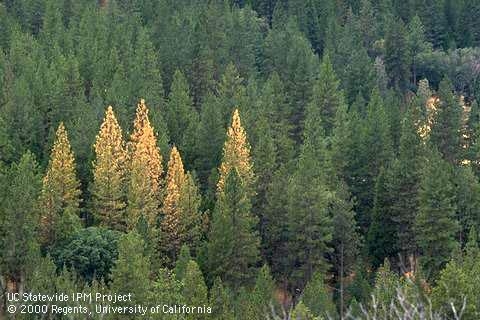
The insects killing trees in the Sierra are all native insects that are multiplying because of drought conditions. Native insects are a necessary part of the forest ecosystem that speed decay of wood back into nutrients, prey on other insects, and provide food for wildlife. They are normally present at low levels and cause tree mortality only in localized areas.
However, drought weakens trees and reduces their ability to withstand insect attacks. Normally trees use pitch to expel beetles that attempt to burrow into the tree through the bark. Weakened trees cannot produce the pitch needed to repel these beetles which are able to enter under the bark and lay eggs. Larvae feed on a tree's inner bark cutting off the tree's ability to transport nutrients and eventually kill it. Attacking beetles release chemicals called pheromones that attract other beetles until a mass attack overcomes the tree. Many beetles also carry fungi that weaken the tree's defenses.
Western pine beetle is one of the main culprits killing pines in the Sierra during this drought. It is a bark beetle, one of a genus of beetles named Dendroctonus which literally means ‘tree-killer'. Adult beetles are dark brown and about a quarter-inch long. Adults bore into ponderosa pines, lay eggs which develop into larvae in the inner bark then complete development in the outer bark. When beetle populations are high, such as during drought periods, even healthy trees may not be able to produce enough pitch to ward off hundreds of beetle attacks.
Western pine beetle often attacks in conjunction with other insects. Other beetles causing tree mortality in Sierra forests include mountain pine beetle, red turpentine beetle, Jeffrey pine beetle, engraver beetles (Ips) and fir engravers. Forests with a higher diversity of tree species are typically less affected because beetles often have a preference for specific tree species. Some species may attack only one tree type. For example Jeffrey pine beetles attack only Jeffrey pine.

The best defense against bark beetles is to keep trees healthy so they are able fight off insects themselves. Widely spaced trees are typically less susceptible to successful attack by bark beetles since they face less competition for moisture, light, and nutrients compared to densely growing and overcrowded trees. Forest health can be promoted by thinning to reduce overcrowding (so each tree has access to more resources) and removing high risk trees during thinning (such as those that are suppressed or unhealthy).
For landscape trees of high value close to a home, watering may be one option to increase tree vigor against bark beetle attacks. Apply about 10 gallons of water for each inch of tree diameter (measured at chest height) around the dripline of the tree once or several times a month during dry weather.
There are some insecticides registered for bark beetle control, but all are preventative only. Carbaryl may prevent attack for up to two years, while pyrethroids can deter attack for up to a year. Spraying can be tricky because the chemical must be applied up to 50 feet up the trunk of the tree usually while standing on the ground. Since misapplication may have toxic consequences, any insecticide must be administered by a licensed pesticide applicator. All applications must follow the label. Though some systemic treatments applied to the soil or inserted into the tree may work in some cases, there is not a lot of documented evidence that they are effective against western pine beetle. No insecticide can prevent tree death once a tree has been successfully attacked.
Author: Susie Kocher, UC Agriculture and Natural Resources Cooperative Extension advisor
Decline of coast live oak trees in S. California is due to fungus

“We have found declining coast live oak trees throughout urban landscapes in Los Angeles, Orange, Riverside, Santa Barbara, Ventura and Monterey counties,” said Akif Eskalen, UC Cooperative Extension specialist in the Department of Plant Pathology and Microbiology at the University of California, Riverside.
Eskalen recovered the fungal species, Geosmithia pallida, from tissues of infected coast live oak trees and performed pathogenicity tests on it in his laboratory at UC Riverside. The tests showed that the fungus is pathogenic to coast live oak seedlings and produces symptoms of foamy canker.
The western oak bark beetle, which spreads the fungus, is a small beetle — about 2 millimeters long — that burrows through the bark of the coast live oak tree, excavating shallow tunnels under the bark across the grain of wood. Brown in color, this beetle is native to California. Female beetles lay their eggs in the tunnels. It is not known at this time if the beetle infects trees other than coast live oak trees.
Symptoms of foamy bark canker disease include wet discoloration on the trunk and main branches of the infected coast live oak tree. This discoloration surrounds the entry holes that the western oak bark beetle makes to burrow into the tree. Multiple holes can often be seen on an infected tree.
“When you peel back the outer bark of the infected area, you see bark (phloem) necrosis surrounding the entry hole,” Eskalen said. “As the disease advances, a reddish sap may be seen oozing from the entry hole, followed by a prolific foamy liquid. This foamy liquid, the cause of which remains unknown, may run as far as two feet down the trunk.”
Eskalen explained that when the infection is at an advanced stage, the coast live oak tree dies. Currently, no control methods are in place to control the fungus or the beetle.
If you suspect your coast live oak tree has the symptoms described above, please contact your local UC Cooperative Extension advisor, pest control adviser, county agricultural commissioner's office or Eskalen at akif.eskalen@ucr.edu.
To see more photos, visit http://ucrtoday.ucr.edu/22096.
Mountain pine beetle turns trees into firewood
Tim Paine, professor in the UC Riverside Department of Entomology, discussed wood-boring beetles and wildfires during a six-minute interview on The Madeleine Brand Show, which is broadcast on KPCC, Southern California's public radio affiliate.

"It has killed large numbers of trees in the whole range. in some places upwards of 90 percent of the trees are killed by the beetle. Its devastating," Paine said. "You see vast areas of gray ghosts of trees."
Mountain pine beetles bore through the outer bark of the tree and construct their feeding galleries underneath the bark, disrupting water movement through the tree and killing the tree in the process.
Paine said global climate change appears to be extending the mountain pine beetle's range.
"Apparently, in the higher elevations of the Rocky Mountains, temperatures warmed enough that the beetles are advancing up into higher elevations where they weren't before," Paine said.
Though beetles and fire are part of forests' natural eco-system for millennia, the landscape has been changed by long periods of human fire exclusion. Now, when these areas do burn, the fires are more intense than they would have been otherwise.
